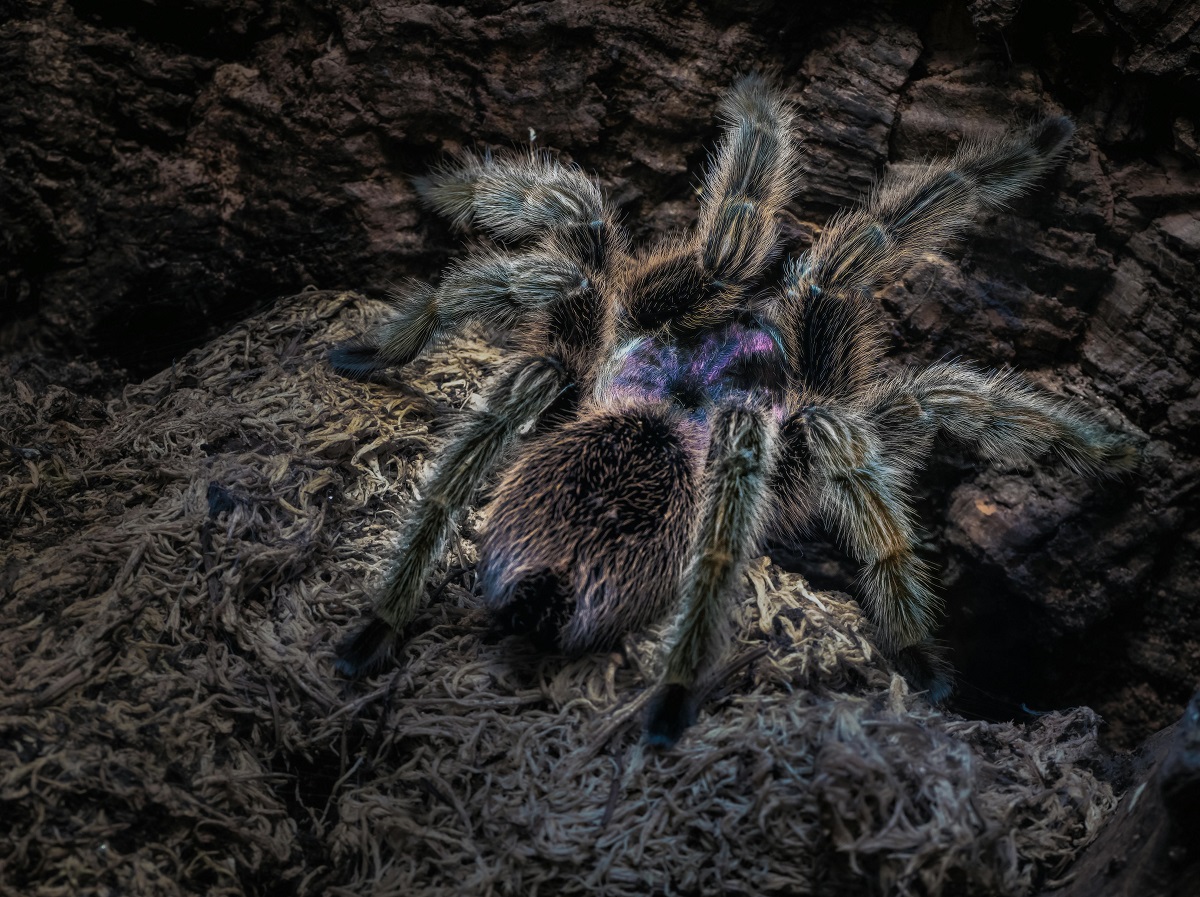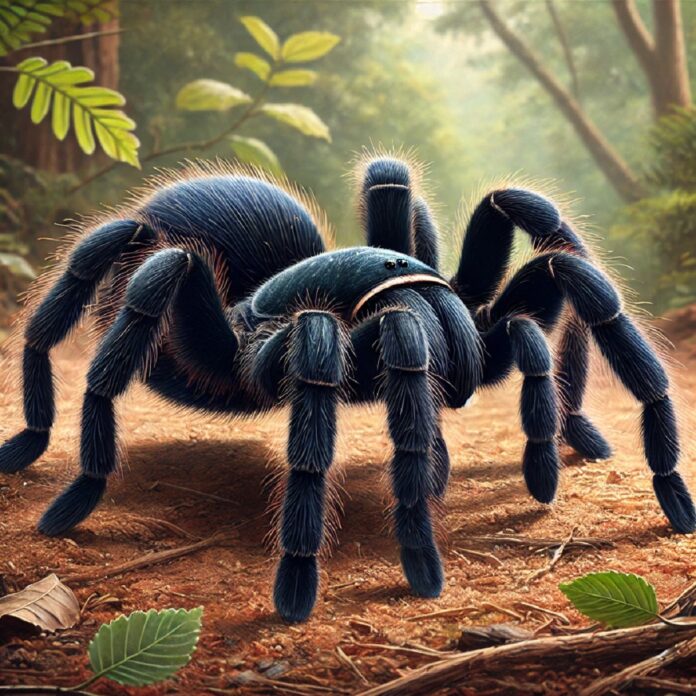The Brazilian black tarantula, scientifically known as Grammostola pulchra, is one of the most sought-after tarantula species in the exotic pet trade.
What makes this particular spider so special is its striking jet-black coloration, calm demeanor, and relatively easy care requirements. Unlike many other tarantulas that display vibrant colors or aggressive tendencies, the Brazilian black tarantula captivates enthusiasts with its sleek, velvety appearance and docile personality.
Native to the grasslands and subtropical regions of southern Brazil, this species has adapted well to captive environments, making it an excellent choice for both beginner and experienced keepers. In this extensive guide, we will explore every aspect of the Brazilian black tarantula, including its natural habitat, behavior, diet, reproduction, proper care in captivity, and conservation status. By the end, you’ll have a thorough understanding of what makes this tarantula unique and why it continues to be a favorite among arachnid lovers worldwide.
Physical Characteristics and Identification

When fully grown, the Brazilian black tarantula is an impressive sight, with adult specimens reaching a leg span of 6 to 7 inches (15 to 18 cm). Unlike some other tarantula species that exhibit color variations or patterns, Grammostola pulchra is known for its uniform, deep black coloration that gives it a sleek and almost metallic appearance under certain lighting conditions.
One of the most notable features of this species is its dense covering of fine hairs, which contribute to its velvety texture. These hairs serve multiple purposes, including sensory functions and defense mechanisms. Like all tarantulas, the Brazilian black possesses urticating hairs on its abdomen, which it can flick when threatened. These tiny barbed hairs can irritate the skin, eyes, or respiratory tracts of potential predators—or curious humans who handle them carelessly.
Sexual dimorphism in this species is relatively subtle compared to other tarantulas. Males tend to be slightly smaller and more slender, with longer legs in proportion to their bodies. Females are stockier and heavier, with a noticeably broader abdomen, especially when carrying eggs. One of the most reliable ways to distinguish males from females is by examining their pedipalps (small leg-like appendages near the mouth) and the presence of tibial hooks in mature males, which are used during mating.
Natural Habitat and Geographic Distribution
The Brazilian black tarantula is endemic to the subtropical regions of southern Brazil, particularly in the state of Rio Grande do Sul. This area is characterized by a mix of grasslands, scrub forests, and occasional patches of subtropical woodland. The climate in this region is generally warm and humid, with distinct wet and dry seasons, which plays a significant role in the tarantula’s behavior and life cycle.
In the wild, these tarantulas are primarily terrestrial, meaning they spend most of their time on the ground rather than in trees. They are skilled burrowers, often creating extensive underground tunnels or taking refuge under rocks, fallen logs, and dense vegetation. These burrows serve as protection from predators and extreme weather conditions while also providing a stable microclimate with higher humidity levels—something crucial for their survival.
Unlike some tropical tarantula species that thrive in constantly humid environments, the Brazilian black tarantula prefers moderately humid conditions with good airflow. This adaptation makes them somewhat hardier in captivity compared to species that require extremely high humidity, which can sometimes lead to mold or bacterial growth in enclosures if not properly managed.
Behavior and Temperament
One of the main reasons the Brazilian black tarantula is so popular among keepers is its exceptionally calm and docile temperament. While many tarantula species are known for being skittish, defensive, or even aggressive, Grammostola pulchra tends to be slow-moving and reluctant to bite unless severely provoked.
Defensive Behaviors
When threatened, this species typically resorts to one of three defensive strategies:
Retreating – Their first instinct is usually to move away from perceived danger rather than confront it.
Flicking Urticating Hairs – If cornered, they may use their back legs to flick tiny barbed hairs from their abdomen toward the threat.
Rarely, a Defensive Bite – Biting is a last resort, and their venom is mild, comparable to a bee sting for most people.
Activity Patterns
Brazilian black tarantulas are primarily nocturnal, meaning they are most active during the night. During the day, they tend to remain hidden in their burrows or under shelter. However, it’s not uncommon for well-established captive specimens to be seen moving about their enclosures during daylight hours, especially if they associate their keeper with feeding time.
Handling Considerations
While their calm nature might make them seem like ideal candidates for handling, it’s important to remember that tarantulas are delicate creatures. A fall from even a short height can be fatal due to their fragile exoskeletons. Additionally, frequent handling can cause unnecessary stress. If handling is necessary—for enclosure maintenance, for example—it should be done cautiously, allowing the tarantula to walk onto an open hand voluntarily rather than being picked up.
Diet and Feeding Habits
In their natural habitat, Brazilian black tarantulas are opportunistic predators, feeding on a variety of insects and small invertebrates that cross their path. Their diet primarily consists of.
Crickets
Roaches (such as dubia or discoid roaches)
Mealworms and superworms
Occasionally, small lizards or pinky mice (for large adults)
Feeding Frequency by Life Stage
Spiderlings (0-1 inch): Should be fed every 3-4 days with appropriately sized prey (e.g., pinhead crickets or small mealworm segments).
Juveniles (1-4 inches): Can be fed every 5-7 days with medium-sized insects.
Adults (5+ inches): Only require feeding once every 7-10 days with larger prey items.
Important Feeding Notes
Always provide fresh water in a shallow dish, as dehydration is a common issue in captivity.
Remove uneaten prey within 24 hours to prevent stress or injury to the tarantula.
Avoid overfeeding, as obesity can lead to health problems and difficulty during molting.
Molting: A Critical Process in the Tarantula’s Life Cycle
One of the most fascinating aspects of keeping tarantulas is observing their molting process. Like all arthropods, Brazilian black tarantulas must shed their exoskeleton to grow. This process becomes less frequent as they age but remains vital throughout their lives.
Signs of an Impending Molt
Decreased appetite or complete refusal of food
Dull coloration as the new exoskeleton forms beneath the old one
Increased webbing activity to create a “molting mat”
More reclusive behavior than usual
The Molting Process Itself
When ready to molt, the tarantula will flip onto its back—a sight that often alarms new keepers. This position allows the spider to carefully extract itself from its old exoskeleton. The process can take several hours, during which the tarantula is extremely vulnerable and should never be disturbed.
Post-Molt Care
After molting, your tarantula will need:
7-10 days before feeding (until its fangs harden)
Higher humidity helps with the hardening process
Complete privacy and no handling
Reproduction and Breeding Considerations
Breeding Brazilian black tarantulas can be a rewarding experience for dedicated keepers, though it requires patience and careful planning due to their slow maturation rate.
Courtship Rituals
When a mature male is ready to breed (typically indicated by the development of tibial hooks and emboli on his pedipalps), he will create a sperm web and perform a species-specific courtship dance to attract a female. This involves:
Rhythmic tapping on the female’s web
Vibrating his body in specific patterns
Carefully approaching the female to avoid being mistaken for prey
The Mating Process
Actual mating is brief but dangerous for the male. After successfully inserting his sperm into the female’s epigyne, he must retreat quickly to avoid being cannibalized. Successful mating doesn’t guarantee offspring—females can store sperm for months before producing an egg sac.
Egg Sac Development
About 2-3 months after mating, a well-fed female will produce a silken egg sac containing 50-200 eggs. She will fiercely guard this sac for 6-8 weeks until the spiderlings emerge. At this stage, it’s often best to remove the sac for artificial incubation to ensure higher survival rates.
Common Health Issues and Preventive Care
While generally hardy, Brazilian black tarantulas can face several health challenges in captivity.
Dehydration
Symptoms
Shrunken abdomen
Difficulty moving
Staying in water dish
Prevention
Always provide a shallow water dish
Maintain proper humidity (60-70%)
Lightly mist one corner of the enclosure weekly
Parasites and Mites
Signs
Tiny moving dots on the tarantula or substrate
Excessive grooming behavior
Lethargy
Treatment
Complete substrate change
Temporary housing on paper towels
Careful cleaning of the enclosure
Molting Problems
Issues may include
Stuck molt (old exoskeleton not fully shed)
Limb loss during the process
Incomplete hardening of the new exoskeleton
Emergency care
Increase humidity significantly
Provide a “molting ICU” with damp paper towels
Never attempt to manually remove stuck molt
Setting Up the Perfect Enclosure
Creating an ideal habitat is crucial for your tarantula’s health and well-being. Here’s a detailed breakdown:
Enclosure Size and Type
Spiderlings: 4″x4″x4″ plastic containers with ventilation
Juveniles: 8″x8″x8″ acrylic or glass terrariums
Adults: 10-gallon tank or equivalent (12″x12″x12″ minimum)
Essential Components
Substrate: 4-6 inches of moisture-retaining material like:
Coconut fiber
Peat moss
Organic topsoil (pesticide-free)
Hiding Places: Provide at least one secure hide such as:
Cork bark flats
Half-buried clay pots
Commercial reptile caves
Water Source: A shallow, sturdy water dish (bottle caps work for slings)
Decor (Optional): Artificial plants or driftwood for enrichment
Environmental Parameters
Temperature: 75-85°F (24-29°C)
Use an under-tank heater if needed
Never use heat lamps (too drying)
Humidity: 60-70%
Measure with a digital hygrometer
Maintain through substrate moisture and light misting
Ventilation: Crucial to prevent stagnant air
Cross-ventilation is ideal
Mesh tops work, but ensure gaps aren’t large enough for escapes
Myths and Misconceptions About Tarantulas
Despite their popularity, many misunderstandings persist about these fascinating creatures:
All Tarantulas Are Deadly
Reality
No tarantula species has medically significant venom to humans
Brazilian black tarantula bites are rare and comparable to bee stings
The primary risk is from urticating hairs, not venom
Welcome to the Intriguing World of Thomisidae: Your Ultimate Guide
They Need Large Prey Daily
Reality
Overfeeding is more dangerous than underfeeding
Adults only need 1-2 appropriately sized prey items weekly
Spiderlings eat more frequently but in smaller portions
Handling Is Beneficial
Reality
Tarantulas derive no enjoyment from handling
Stress from handling can lead to health issues
They are observation pets, not interactive ones

